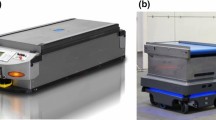Abstract
Trip-based material handling systems such as AGV systems or lift trucks are often designed with a given flow matrix (or from-to chart), which typically shows the number of loaded trips that the devices must perform per unit time between the workstations. A from-to chart that would result from the parts flow in a facility actually is dictated by the transfer batch size; that is, the number of parts transferred from one workstation to the next in one trip. In this paper, we present analytical and simulation results aimed at determining optimal or nearoptimal transfer batch sizes in manufacturing systems and develop an analytical relationship between the material handling capacity and the expected work in process (WIP) in a manufacturing system. Although the results apply to any discrete-parts flow, trip-based material handling system, they are particularly relevant for the electronics manufacturing industry, where parts (such as printed circuit boards or substrates for flat panel displays) typically are handled as a group (in specially designed containers such as cassettes) and the costs associated with WIP tend to be large. In such applications, the cassette size is the transfer batch size.
Similar content being viewed by others
References
BertrandJ.W.M., “Multiproduct Optimal Batch Size with In-Process Inventories and Multi Work Conters,” IIE Transactions, Vol. 17, No. 2, pp. 157–163 (1985).
BozerY.A., ChoM.S., and SrinivasanM.M., “Expected Waiting Times in Single-Device Trip-Based Material Handling Systems,” European Journal of Operational Research, Vol. 75, pp. 200–216 (1994).
Cho, M.S., “Design and Performance Analysis of Trip-Based Material Handling Systems in Manufacturing,” Ph.D. dissertation, Department of Industrial and Operations Engineering, The University of Michigan, Ann Arbor, MI (1990).
ChowW.M., “Design for Line Flexibility,” IIE Transactions, Vol. 18, No. 1, pp. 95–108 (1986a).
ChowW.M., “An Analysis of Automated Storage and Retrieval Systems in Manufacturing Assembly Lines,” IIE Transactions, Vol. 18, No. 2, 204–214 (1986b).
EgbeluP.J., “The Use of Non-Simulation Approaches in Estimating Vehicle Requirements in an Automated Guided Vehicle Based Transport System,” Material Flow, Vol. 4, Nos. 1–2, pp. 17–32 (1987).
EgbeluP.J., “Economic Design of Unit Load-Based FMSs Employing AGVs for Transport,” International Journal of Production Research, Vol. 31, No. 12, pp. 2753–2775 (1993a).
EgbeluP.J., “Concurrent Specification of Unit Load Sizes and Automated Guided Vehicle Fleet Size in Manufacturing System,” International Journal of Production Economics, Vol. 29, pp. 49–64, (1993b).
GoldbergD.E., Genetic Algorithms, Addison-Wesley Publishing Co., New York, NY (1989).
GrassoE.T. and TanchocoJ.M.A., “Unit Load and Material Handling Considerations in Material Requirements Systems,” Material Flow, Vol. 1, pp. 79–87 (1983).
HollandJ.H., Adaptation in Natural and Artificial Systems, The University of Michigan Press, Ann Arbor, MI (1975).
JackmanJ., “Unit Load Size Determination Based on Economic Move Quanty,” Journal of the Operational Research Society, Vol. 42, No. 8, pp. 703–711 (1991).
KarmarkarU.S., KekreS., KekreS., and FreemanS., “A Novel Analytical Lot-Sizing Model (Q-LOTS), ” Interfaces, Vol. 15, No. 2, pp. 1–9 (1985).
Kim, J., “Transfer Batch Sizing in Trip-Based Material Handling Systems,” Ph.D. dissertation, Department of Industrial and Operations Engineering, The University of Michigan, Ann Arbor, MI (1995).
KuehnP.J., “Approximate Analysis of General Queueing Networks by Decomposition,” IEEE Transactions on Communications, Vol. COM-27, No. 1, pp. 113–126 (1979).
MahadevanB. and NarendranT.T., “Determination of Unit Load Sizes in an AGV-Based Material Handling System for an FMS,” International Journal of Production Research, Vol. 30, No. 4, pp. 909–922 (1992).
NozakiS. and RossS., “Approximations in Finite Capacity Multiserver Queues with Poisson Arrivals,” Journal of Applied Probability, Vol. 15, pp. 826–834 (1978).
RossS.M., Introduction to Probability Theory, Academic Press Inc., Orlando, FL (1985).
SolbergJ.J., “Capacity Planning with a Stochastic Workflow Model,” AIIE Transactions, Vol. 13, No. 2, pp. 116–122 (1981).
SolotP. and BastosJ.M., “MULTIQ: A Queueing Model for FMSs with Several Pallet Types,” Journal of the Operational Research Society, Vol. 39, No. 9, pp. 811–821 (1988).
SrinivasanM.M., BozerY.A., and ChoM.S., “Trip-Based Material Handling Systems: Throughput Capacity Analysis,” IIE Transactions, Vol. 26, No. 1, pp. 70–89 (1994).
YaoD.D. and BuzacottJ.A., “Modeling the Performance of Flexible Manufacturing Systems,” International Journal of Production Research, Vol. 23, No. 5, pp. 945–959 (1985).
YaoD.D. and BuzacottJ.A., “Models of Flexible Manufacturing Systems with Limited Local Buffers,” International Journal of Production Research, Vol. 24, No. 1, pp. 107–118 (1986).
YaoD.D. and BuzacottJ.A., “Modeling a Class of Flexible Manufacturing Systems with Reversible Routing,” Operations Research, Vol. 35, No. 1, pp. 87–93 (1987).
Author information
Authors and Affiliations
Rights and permissions
About this article
Cite this article
Bozer, Y.A., Kim, J. Determining transfer batch sizes in trip-based material handling systems. Int J Flex Manuf Syst 8, 313–355 (1996). https://doi.org/10.1007/BF00170017
Issue Date:
DOI: https://doi.org/10.1007/BF00170017




